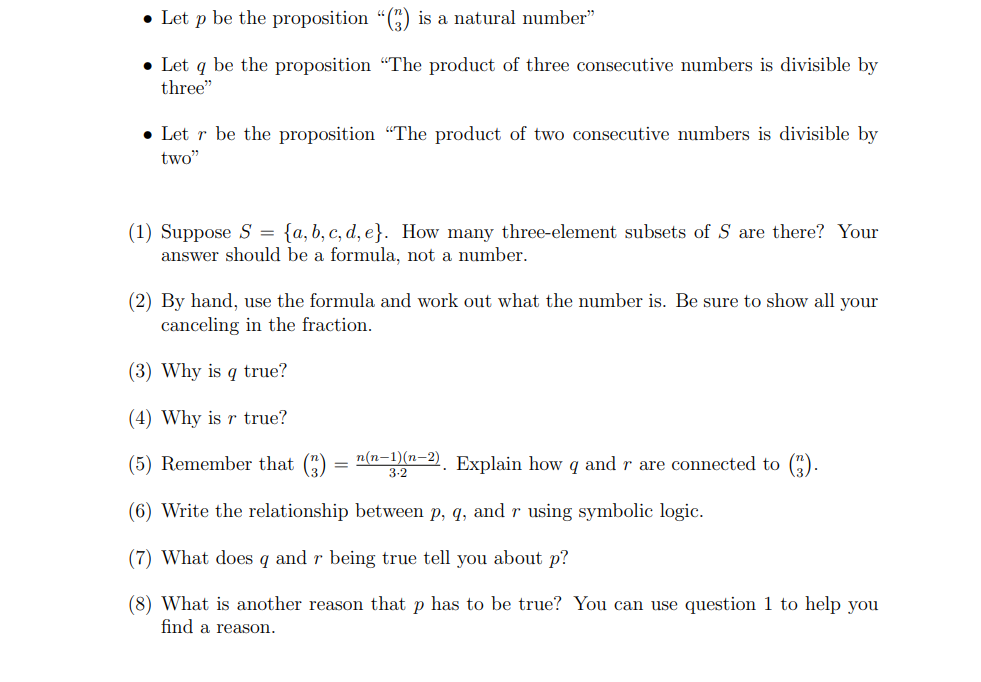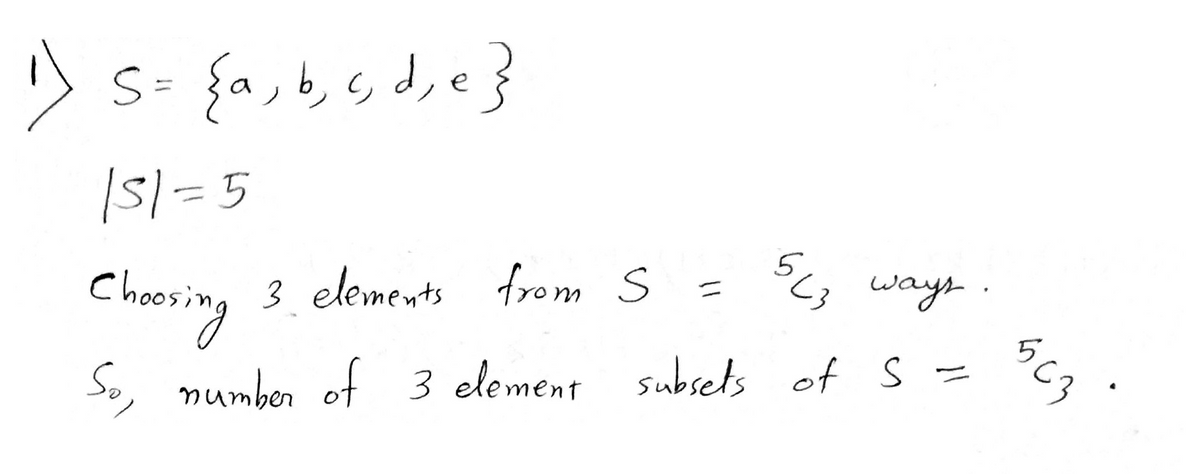● Let p be the proposition "() is a natural number" Let q be the proposition "The product of three consecutive numbers is divisible by three" Letr be the proposition "The product of two consecutive numbers is divisible by two" ) Suppose S = {a, b, c, d, e}. How many three-element subsets of S are there? Your answer should be a formula, not a number.
● Let p be the proposition "() is a natural number" Let q be the proposition "The product of three consecutive numbers is divisible by three" Letr be the proposition "The product of two consecutive numbers is divisible by two" ) Suppose S = {a, b, c, d, e}. How many three-element subsets of S are there? Your answer should be a formula, not a number.
Advanced Engineering Mathematics
10th Edition
ISBN:9780470458365
Author:Erwin Kreyszig
Publisher:Erwin Kreyszig
Chapter2: Second-order Linear Odes
Section: Chapter Questions
Problem 1RQ
Related questions
Question
Please help solve all parts and explain answer for me. Thanks a lot.

Transcribed Image Text:• Let p be the proposition "() is a natural number"
• Let q be the proposition "The product of three consecutive numbers is divisible by
three"
Letr be the proposition "The product of two consecutive numbers is divisible by
two"
(1) Suppose S = {a, b, c, d, e}. How many three-element subsets of S are there? Your
answer should be a formula, not a number.
(2) By hand, use the formula and work out what the number is. Be sure to show all your
canceling in the fraction.
(3) Why is q true?
(4) Why is r true?
(5) Remember that (3) n(n-1)(n-2). Explain how q and r are connected to (3).
=
(6) Write the relationship between p, q, and r using symbolic logic.
(7) What does 9 and r being true tell you about p?
(8) What is another reason that p has to be true? You can use question 1 to help you
find a reason.
Expert Solution
Step 1
NOTE: According to guideline answer of first three subpart can be given, for other please ask in a different question and specify the question number .

Step by step
Solved in 3 steps with 3 images

Follow-up Questions
Read through expert solutions to related follow-up questions below.
Follow-up Question
Please this is a follow up question. Kindly write solutions clear just like from the first solution. And please, help solve all remaining questions for me please. Thanks for understanding.

Transcribed Image Text:(4) Why is r true?
(5) Remember that (3)
(6) Write the relationship between p, q, and r using symbolic logic.
(7) What does q and r being true tell you about p?
(8) What is another reason that p has to be true? You can use question 1 to help you
find a reason.
=
n(n-1)(n-2) Explain how q and r are connected to (3).
3-2
Solution
Recommended textbooks for you

Advanced Engineering Mathematics
Advanced Math
ISBN:
9780470458365
Author:
Erwin Kreyszig
Publisher:
Wiley, John & Sons, Incorporated

Numerical Methods for Engineers
Advanced Math
ISBN:
9780073397924
Author:
Steven C. Chapra Dr., Raymond P. Canale
Publisher:
McGraw-Hill Education

Introductory Mathematics for Engineering Applicat…
Advanced Math
ISBN:
9781118141809
Author:
Nathan Klingbeil
Publisher:
WILEY

Advanced Engineering Mathematics
Advanced Math
ISBN:
9780470458365
Author:
Erwin Kreyszig
Publisher:
Wiley, John & Sons, Incorporated

Numerical Methods for Engineers
Advanced Math
ISBN:
9780073397924
Author:
Steven C. Chapra Dr., Raymond P. Canale
Publisher:
McGraw-Hill Education

Introductory Mathematics for Engineering Applicat…
Advanced Math
ISBN:
9781118141809
Author:
Nathan Klingbeil
Publisher:
WILEY

Mathematics For Machine Technology
Advanced Math
ISBN:
9781337798310
Author:
Peterson, John.
Publisher:
Cengage Learning,

